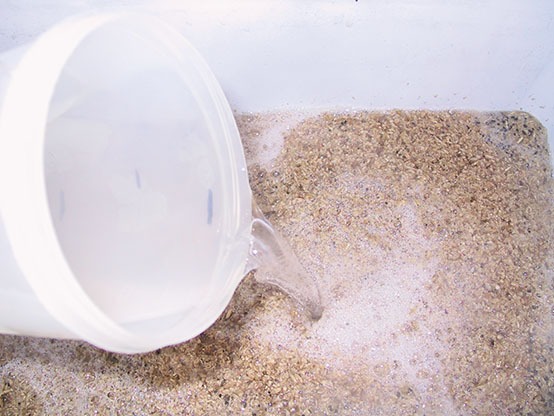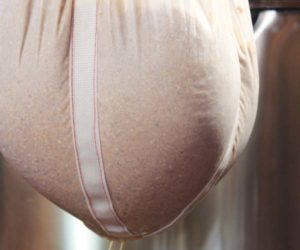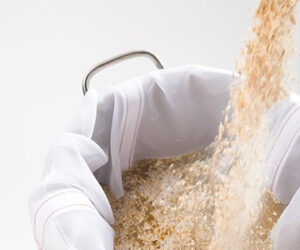Batch Sparging

All of the technical jargon hides two pretty simple steps: Mashing and lautering. Most homebrewers use a single infusion mash, which means you add some hot water to your crushed grains to achieve a target temperature of somewhere around 152 °F (67 °C) for the mixture, and then hold it there for an hour or so. Heating the grain-water mixture up and holding it allows some natural enzymes in the grains to break down long unfermentable sugar chains into short ones (maltose) that yeast loves.
The second step is technically called lautering, though it is often loosely referred to as sparging. Lautering is the “larger” term encompassing the entire three-step process of a mash out, recirculation and sparging. The purpose of lautering is to extract the sugary liquid we call wort from the spent grains so we can boil it with hops to brew beer.
There are several possible sparging methods, though we’ll be focusing in on batch sparging for this particular article.
Sparging Methods
Some homebrewers may be surprised to find out there are at least four sparging methods you can use to extract sugary wort from your grains after the mash. The most traditional is fly sparging, which we discussed in the last article. However, we’re going to go into detail in this article on batch sparging as it is probably the most popular option for homebrewers. But first, let’s take a look at the differences between the most common sparging methods.
Fly Sparging: A fly sparge involves continuously adding hot water to the top of the mash tun as it is drained from the bottom. This is the method most commercial brewers employ, often using fixed nozzles used to spray water in a cone pattern over the bed, or sometimes (although not nearly as often since the 1980s) with a spinning arm at the top of the lauter tun that sprays water over the top of the grain bed. The flow of water is carefully managed so that the same amount of water is flowing into the grain bed as is draining out.
No Sparge: In a “no sparge” technique, a larger mash vessel is used and enough water is added to the mash tun to account for a “full boil” volume when drained. Since all of the water is already in the mash tun, no sparge water is added, and instead the mash tun is simply drained off into the boiler after mashing.
Brew-in-a-Bag (BIAB): Brew-in-a-bag is a variation of no sparge, except that there is no separate mash tun. Instead the mash is done inside of a bag placed within the boil vessel. Like no sparge, enough water is added to achieve a full boil volume after draining the grains. So instead of sparging or adding water, for BIAB you just lift the grain bag out of the boiler after the mash leaving enough wort behind to brew. (Read more about using the brew-in-a-bag technique in this issue on page 30.)
Batch Sparging: Batch sparging is a popular technique with many homebrewers, and is a bit of a hybrid approach. This method uses a normal sized mash tun, but water is added in large batches to the mash tun during the sparge and then drained fully at each step (see the sidebar on page 58 for the process). Batch sparging has some advantages in terms of time, equipment required and efficiency, which is why it has become a very popular method.
The Advantages of Batch Sparging
Batch sparging has some advantages over fly sparging or even BIAB and no-sparge techniques. These include:
Minimal Equipment. You don’t need a separate fly sparge arm, and you don’t need the larger mash tun or pot associated with no-sparge or BIAB methods. For most batches, a 5-gallon (19-L) cooler with a false bottom is sufficient for a 5-gallon (19-L) batch of beer.
Simplicity. You don’t have to manage the continuous flow of water and wort as you would in a fly sparge.
Traditional Water to Grain Ratios. You can batch sparge with just about any desired water to grain ratio, including the traditional ranges of 1.25–1.5 quarts/lb. (roughly 1 L of water per kg of grain). BIAB or no-sparge methods require the full volume of water in the mash tun, so you would have to mash at a much higher water to grain ratio.
Efficiency. If properly done, batch sparging can be nearly as efficient as fly sparging.
Time Saving. Because you simply pour and then drain water in the mash tun, batch sparging generally takes less time than fly sparging.
Batch Sparging Calculations
You can perform a batch sparge with minimal calculations. Assuming your mash tun size is not overly large, simply fill up the mash tun with hot water after the mash and drain it. Measure what you have so far in the kettle, and then add enough water to the second batch to achieve your desired pre-boil volume. For lots of homebrewers who aren’t worried about the math, that’s all you need to know.
However, if you want to be more specific, sparging with unequal batches is not optimal, and will generally result in lower extract efficiency. To achieve the highest possible efficiency you need to size your batch steps so each one has equal runnings — i.e. you draw the same amount of water from the mash tun at each step.
I’ll describe the manual steps to calculate the volumes later, though you can easily make a spreadsheet or use brewing software to do these calculations for you. If you are interested in doing the math, however, here are the steps:
- Estimate your pre-boil volume — how much wort you need to collect from sparging.
- Determine how much of your mash water is absorbed by your grains.
- Calculate the sparge volume available for mashing based on both your mash tun volume and grain bill.
- Divide your pre-boil volume by the sparge volume available to determine how many batch steps are needed (typically two to three steps).
- Evenly divide the water in the mash plus sparge water added to create equal runnings for each batch sparge step.
The first number you need to determine is your desired pre-boil volume, which is the amount of wort you need going into the boiler after sparging. Typically you get this by taking your batch size and adding in your trub loss and boil off losses. For a 5-gallon (19-L) batch you might lose a few quarts (liters) to trub and a few more to boil off, so your pre-boil volume would be in the 6.5-gallon (24.6-L) range.
Pre_Boil_Vol = Batch_size + Boil_losses + Trub_losses
Grain Absorption
Next we need to know how much wort we already have in the mash tun that can be drawn off during the sparge. This we can calculate from the water added for the mash, minus a portion that gets absorbed by the grains. The grain absorption can be estimated as 0.12 gallons/lb. or 1 liter/kg of grain.
Grain_absorb = 0.12 gal/lb. x lbs._of_grain
So let’s pretend that we have 10 lbs. (4.5 kg) of grain in our recipe, and mash in with 1.5 quarts/lb. or 15 qts. of water (3.75 gallons). The water absorbed by the grains is then 0.12 x 10 = 1.2 gallons of water. So this means that the most wort we can draw from the grain bed after mashing is 3.75 – 1.2 = 2.55 gallons without adding more water.
Mash Tun Volume Available and Sparge Steps
The next step is to determine how many batch sparge steps are required to achieve our boil volume. Sparging with fewer batch steps is most efficient (two works for most beers) but if you are brewing with a lot of grains or a small mash tun, more steps are sometimes required. It depends on how large your mash tun is and how much grain you are using.
The grain itself occupies a certain volume in the mash tun — roughly 0.312 qt./lb. (0.652 L/kg) in addition to the water absorption we calculated above. If we add these together we get 0.792 qts./lb. (1.652 L/kg) that the wet grain occupies. So for a batch with 10 lbs. (4.5 kg) of grain, the wet grains take up 7.92 quarts (about 2 gal. or 7.5 L). This means if we are using a 5-gallon (19-L) mash tun to mash 10 lbs. (4.5 kg) of grain, we have slightly less than 3 gallons (11 L) of usable volume left per step.
Grain_volume_used = 0.312 qt./lb. x Lbs._of_grain
Sparge_vol_available = Mash_tun_vol – Grain_volume_used
We can now see how the mash tun size and amount of grain drives the number of steps. We simply divide the pre-boil volume by the sparge volume available to figure out how many sparge steps are needed. If we truly want 6.5 gallons (25 L) of wort pre-boil, we would be unable to get that in two batch sparge steps of less than 3 gallons (11 L) each, and would be forced to go to a third sparge step.
Number_sparge_steps = Pre_boil_volume / Sparge_vol_available
However, if we had slightly less grain, a larger mash tun or perhaps needed less wort in the boil, we could then fit our batch sparge into two steps.
Calculating Batch Sparge Additions
From the previous calculations, we now have everything we need to determine the water needed for each step, as well as the number of batch sparge steps needed. Using the example we followed earlier, we would need three batch steps to get 6.5 gallons (24.6 L) of pre-boil wort.
To maximize efficiency, you generally want the same amount of wort drawn from each batch step. So what we will be doing now is evenly spreading the water already in the mash tun plus the sparge water we will add across the three steps. The first step is the one where things are different, since you already have wort in the mash tun from the mashing process.
Desired_batch_step_vol = Pre_boil_volume / Number_sparge_steps
From our example, we determined our pre-boil volume was 6.5 gallons (24.6 L), and we need three steps. So the desired batch step volume to draw from each step is 6.5 gal/3 = 2.16 gallons (8.2 L). However, we already added 3.75 gallons (14 L) of water for the mash itself, of which the grain absorption was 1.2 gallons (calculated earlier). So 2.55 gallons (9.6 L) of wort is available in the mash tun, leftover from the mash itself.
So the 2.55 gallons (9.6 L) in the cooler is sufficient to cover the first batch step — we can simply draw the wort off the mash for our first step to collect the 2.16 gallons (8.2 L) desired. This leaves 2.55-2.16 = 0.39 gallons of wort in the mash tun.
So for our second batch step we want to draw the desired 2.16 gallons (8.2 L) off again, but already have 0.39 gal (1.48 L) in the mash tun, so we only need to add 2.16 – 0.39 = 1.77 gallons (6.7 L) of water to the second batch and then drain it fully.
For the third batch step, we again add the desired batch volume of 2.16 gallons (8.2 L) and drain it to finish collecting the wort for our boil. So even though we add different amounts of water for each step (zero, 1.77 gal./
6.7 L and 2.16 gal./8.2 L) we are always drawing the same 2.16 gallons (8.2 L) of wort from each batch step.
As I said earlier, you can use brewing software or a spreadsheet to simplify batch sparging calculations — you don’t have to manually run these numbers unless you really want to. Also, you don’t have to be super-precise with each addition if you are not as concerned about maximizing efficiency. You should just strive to draw about the same amount of wort from each batch step, and try to hit your target pre-boil volume so you have sufficient wort to finish your batch.
Considerations and Pitfalls
Some people are concerned about the efficiency of batch sparging, where efficiency is simply the percentage of potential sugars you can extract from the grains. Some brewers report slightly lower efficiency when batch sparging than they get with a slow fly sparge. My personal experience is that the efficiency for batch sparging is comparable to the numbers I get from fly sparging. However if you do get lower efficiency with batch sparging, you can compensate by adding a bit more grain to the recipe or lowering your brewhouse efficiency in your brewing software.
A second concern is a stuck sparge, which can occur when your grain bed gets compacted and actually stops the flow of wort from the mash tun. This is usually not a concern with barley based recipes but can occur when you are using a large percentage of cereal adjuncts such as wheat or oats. It is a higher risk with batch sparging than fly sparging, since you completely drain the mash tun for each step, and the grain bed is no longer floating. A potential remedy is to use rice hulls in the mash (which are flavor neutral) to maintain flow, or in worst cases to stir the mash to reopen channels in a stuck sparge.



